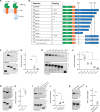Identification of HCN1 as a 14-3-3 client
- PMID: 35679272
- PMCID: PMC9182292
- DOI: 10.1371/journal.pone.0268335
Identification of HCN1 as a 14-3-3 client
Abstract
Hyperpolarization activated cyclic nucleotide-gated channel 1 (HCN1) is expressed throughout the nervous system and is critical for regulating neuronal excitability, with mutations being associated with multiple forms of epilepsy. Adaptive modulation of HCN1 has been observed, as has pathogenic dysregulation. While the mechanisms underlying this modulation remain incompletely understood, regulation of HCN1 has been shown to include phosphorylation. A candidate phosphorylation-dependent regulator of HCN1 channels is 14-3-3. We used bioinformatics to identify three potential 14-3-3 binding sites in HCN1. We confirmed that 14-3-3 could pull down HCN1 from multiple tissue sources and used HEK293 cells to detail the interaction. Two sites in the intrinsically disordered C-terminus of HCN1 were necessary and sufficient for a phosphorylation-dependent interaction with 14-3-3. The same region of HCN1 containing the 14-3-3 binding peptides is required for phosphorylation-independent protein degradation. We propose a model in which phosphorylation of mouse S810 and S867 (human S789 and S846) recruits 14-3-3 to inhibit a yet unidentified factor signaling for protein degradation, thus increasing the half-life of HCN1.
Conflict of interest statement
The authors have declared that no competing interests exist.
Figures






References
-
- Bonzanni M, DiFrancesco JC, Milanesi R, Campostrini G, Castellotti B, Bucchi A, et al.. A novel de novo HCN1 loss-of-function mutation in genetic generalized epilepsy causing increased neuronal excitability. Neurobiol Dis. 2018;118:55–63. Epub 2018/06/25. doi: 10.1016/j.nbd.2018.06.012 . - DOI - PubMed
Publication types
MeSH terms
Substances
Grants and funding
LinkOut - more resources
Full Text Sources
Research Materials

